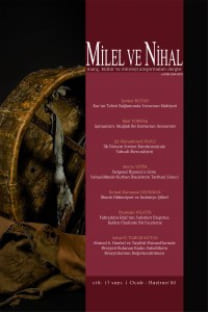"Öteki” ile “Beriki” Arasındaki Salınımda Dinlerde Birlikte ve Beraber Yaşamanın Teolojik ve Pratik İmkânı
Ortaya koydukları âlem ve insan tasavvurlarına göre değişmekle beraber dinler, hem bu dünyada, hem de vaat edilen öte dünyada mutluluk ve huzuru sağlamayı hedefleyen hakikat iddialarında ve bu hakikate bağlı kurtuluş iddialarında tekildir ve biriciktir. Bu hakikat ilkesine ve buna bağlı akideye göre ördüğü birey ve toplum projesinde de dinler kendi "berikileri"ni kurarken, aynı zamanda kurtuluş havzasından ırak kabul edilen "ötekiler"i de kurgular. Hiyerarşik ve seçkinci yapıya göre şekillenen kült eksenli medeniyet yapılarının ve en başta homojenleştirici ve ayrıştırıcı Moderniténin oluşturduğu durumun sonucunda karşımıza çıkan birlikte yaşayamama sorunu karşısında bu çalışma şu safhalarda konuyu analiz etmeyi hedefler: (1) Teşhis (Sorunun tarihsel, teolojik ve varoluşsal kaynak ve kökenleri); (2) Tedavi Potansiyelleri (tarihten, zamanın ruhundan ve ilkelerden devşirilecek); (3) Terapi / Tedavi . Tedavi de şu terapi türlerini ve özelliklerini kapsar: Ontolojik Pota, Epistemolojik Platform, Etik / Ahlâk Perspektifi, Estetik Prensipler, Tarihsel Panorama, Sosyo-Ekonomik ve Sosyo-Politik Pusula ve İnsan-Dünya-Evren-Tanrı Piramidi. Tedavi ile ulaşılacak sonuç da (çalışmanın tezi) şudur: İnsan, kendi geleceği ve dünya-evrenin devamı için te'âruf ("danış olma, irfanlaşma ile ümrana ve kardeşliğe evriliş) ruhu ile küresel bir convivencia ("birlikte ve beraber yaşama")yı veya genel bir mixvarvaroi (“alacalı oluş”)yı gerçekleştirir. Bu durumda dinlerin "öteki" ile "beriki" arasındaki daha çok güç kaynaklı salınımını insanları "beriki kılma" ile sulha eriştirecektir. Bu da geleceği ve karakteri birbirine bağlı evrensel bir huzur zincirinin inşasına imkan verebilecektir.
Anahtar Kelimeler:
Birlikte Yaşama Kültüre ve Haleti, Öteki, Beriki, Modernité / Post/modernité, Te‘âruf, Convivencia, Mixvarvaroi, İrfanlaşma, Küresel huzur zinciri, Teşhis, Terapi Potansiyeli, Terapi.
Theological and Practical Possibility of Living Together in Religions Within the Context of Oscillation Between “the Other” and “the Nearer”
Though changing in accord with the concepts of cosmology and anthropology set out by themselves, religions are monopolist, unique, and exclusive in terms of both the truth claims that are destined to provide happiness and tranquility both in this world, and in the next realm, and of the salvage paradigms dependent upon this truth. In the individual and societal project of religions weaved according to that truth principle, and to the creed based on this principle, religions construct their “nearer”, while forming the “other”, who are regarded as outside of salvation. In order to solve the problem of inability to live together caused by an ethos created by cult-centric civilizational modes, which are both hierarchical and elitist, and especially by the homogenizing and disjointing manifestations of Modernité, this study aims at disentangling this problem with the following phases: (1) Diagnosis (historical, theological, and existential sources of the problem); (2) Potentialities of Prognosis (to be recruited from history, Zeitgeist, and mores-codes); (3) Therapy. And this therapy may cover the following types, source, or modes of therapeutical procedures: Ontological Pot, Epistemological Platform, Ethical / Moral Perspective, Aesthetical Principles, Historical Panorama, Socio-economic and Socio-politic Compass, and Human-World-Cosmos-God Pyramid. The end (the thesis of this study) that will be reached by this therapeutical procedures is this: For her/his own future and that of the world and cosmos, human being realizes and actualizes a global convivencia (“living together and unisonously”), or a general mixvarvaroi (“variegated becoming”) through the sprit of ta ‘âruf (evolving into civilization- prosperity and fraternity via “acquaintance and wisdomization”). Thenceforth, the undulation between “other” and “nearer” within religions largely based on power struggle and search may able to reach tranquility and peace (salam / “i”slam) via making human being “nearer” of the constructing subject. And thus this sets the stage for constructing a chain of global peace and tranquility, of which destiny and character is dependent upon each other.
Keywords:
Culture and ethos of living together Other, Nearer, Modernité, Post/modernité, Ta‘âruf, Convivencia, Mixvarvaroi, Wisdimization, Chain of global peace and tranquility, Diagnosis, Prognosis, Therapy.,
___
- Yavuz, Şevket, (2009). Theological and Practical Possibility of Living Together in Religions Within the Context of Oscillation Between “the Other” and “the Nearer”, Milel ve Nihal, 6 (2), 31-50.
- ISSN: 1304-5482
- Yayın Aralığı: Yılda 2 Sayı
- Başlangıç: 2003
- Yayıncı: Milel ve Nihal: Eğitim, Kültür ve Düşünce Platformu Derneği
Sayıdaki Diğer Makaleler
İki Sultan, St. Francis, Fransiskenler ve Bir Arada Yaşama Sorunu
Islam and Global Dialogue: Religious Pluralism and the Pursuit of Peace
Dua Üzerine Düşünceler (Psikofizyolojik Sebepleri ve Sonuçları)
Diyanet'in Dinlerarası Diyalog Algısı
